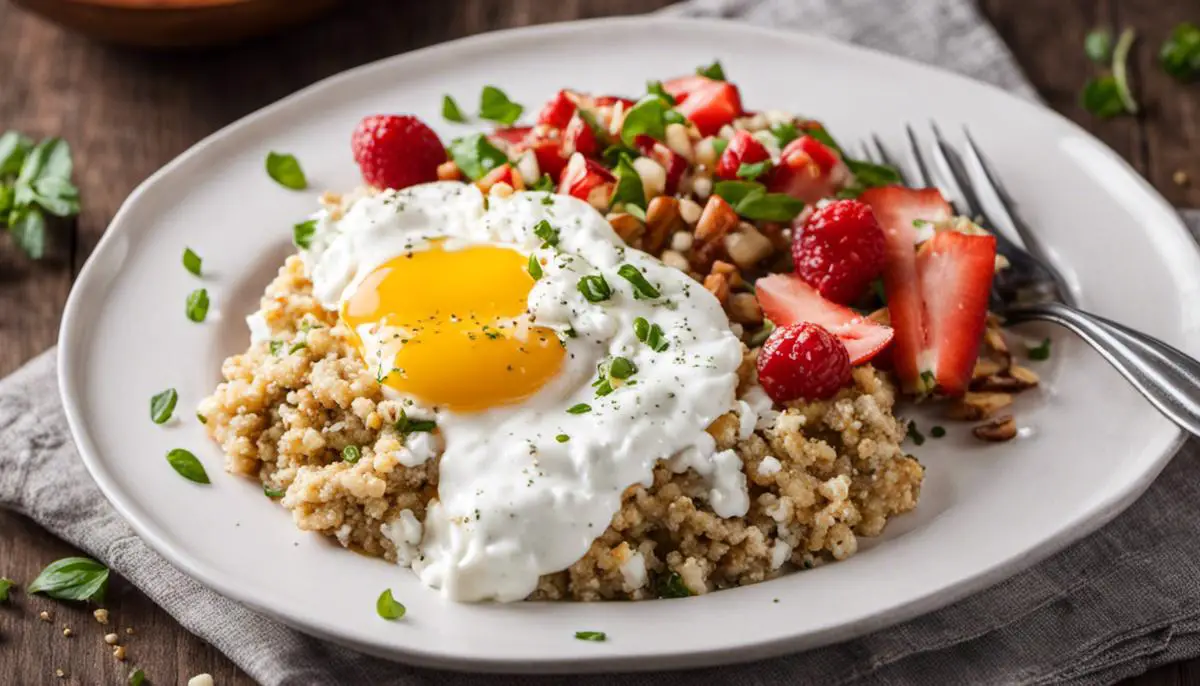Living with diabetes can often feel like a challenging task, but understanding the right balance of nutrients can help to manage this lifestyle effectively. One major aspect of a balanced diabetic diet is the crucial need for protein, especially during breakfast. The importance of protein lies in its ability to stabilize blood sugar levels. Comprehending the relationships between insulin, sugar, carbohydrates, and proteins is key to managing diabetes and maintaining a healthful lifestyle. It becomes, therefore, essential to identify various protein sources like lean meats, legumes, low-saturated fat dairy products, and certain types of fish that are beneficial for those managing diabetes.
Understand Diabetes and Diet
Understanding Diabetes and its Impact on the Body
Diabetes is a chronic medical condition that interferes with the body’s ability to process blood glucose, also known as blood sugar. In a healthy body, the hormone insulin aids in the movement of glucose into cells, where it’s then used for energy. However, for individuals with diabetes, this system doesn’t function properly. In type 1 diabetes, the body doesn’t produce insulin. In type 2 diabetes, the body either doesn’t make enough insulin or doesn’t use it effectively, causing glucose to stay in the bloodstream, resulting in high blood sugar levels.
Chronic high blood sugar can lead to serious health complications, such as heart disease, stroke, kidney disease, and nerve damage. Thus, it’s crucial for those with diabetes to manage sugar intake and maintain balanced blood glucose levels.
Significance of Breakfast in Diabetes Management
Research indicates that breakfast is the most crucial meal of the day for people with diabetes. A balanced breakfast sets the metabolic pace for the day, helps distribute carbohydrate intake evenly, and prevents blood sugar spikes and crashes. Missing breakfast can lead to fasting for too long, causing a significant rise in blood sugar levels. This is often referred to as the “dawn phenomenon”.
Role of Carbohydrates, Sugar, and Insulin in Diabetes
Carbohydrates and sugars are the primary sources of glucose, the body’s main energy source. Insulin acts as a key for glucose to penetrate cells, facilitating its conversion into energy. For diabetics, whose bodies can’t produce or use insulin well, these carbs and sugars can’t be processed correctly, resulting in high blood glucose levels, or hyperglycemia.
While a healthy diet is crucial for everyone, it’s particularly important for those with diabetes. They must be careful about what and when they eat, as foods high in carbs or sugar can cause blood glucose levels to spike, leading to possibly serious health consequences.
Importance of Proteins in a Diabetic Diet
Proteins play a critical role in a balanced diabetic diet because they have a minimal effect on blood glucose levels. Unlike carbs, proteins don’t cause a rapid rise in blood sugar. This helps in maintaining steady blood glucose levels and prevents spikes, making proteins an essential part of a diabetic diet.
Furthermore, proteins contribute to satiety, helping individuals feel full longer and reducing the likelihood of overeating. For a protein-rich diabetic breakfast, include food items like eggs, Greek yogurt, cottage cheese, nuts, and seeds. protein shakes can also be a quick and easy option.
Regular physical exercise, along with a balanced and protein-rich diet, helps in effective management of diabetes. Always consult with a healthcare provider to establish a diet and exercise plan that’s tailored to individual health needs and lifestyle.

Protein Sources Beneficial for Diabetics
Sources of Protein for Diabetics
Diabetes requires careful management of diet, with special attention towards maintaining a balance of insulin and glucose in the body. Protein plays an essential role in this process. Lean meats, legumes, low-fat dairy products, and certain types of fish are all excellent sources of protein that can contribute to a healthy and balanced diet for diabetics.
Lean Meats
Lean meats such as turkey, chicken, and lean cuts of pork and beef are good sources of protein with little to no carbohydrates. These meats are also typically low in saturated fats, which are harmful to cardiovascular health. These meats provide the body with essential amino acids that it needs to build and repair tissues, including muscles and bones.
Legumes
Legumes such as beans, lentils, and peas are packed with proteins and fibers. This combination works wonders in maintaining blood sugar levels, as fibers slow down the absorption of sugars into the bloodstream, ensuring a steady energy release. Besides their protein content, legumes are rich in vitamins and minerals that support overall health.
Low-fat Dairy Products
Dairy products are another great source of protein, but diabetes sufferers should focus on low-fat and non-fat options to avoid the adverse effects of saturated and trans fats. Dairy products such as milk, cheese, and yogurt not only provide high-quality protein but are also a good source of calcium and vitamin D, critical for bone health.
Protein-rich Fish
Fish, especially fatty ones like salmon, mackerel, sardines, and albacore tuna, are loaded with protein and beneficial omega-3 fatty acids. These fats help reduce inflammation and may lower the risk of heart disease. Fish is a high-quality protein source and can help regulate blood sugar levels, crucial for diabetic individuals.
Protein’s Role in the Body and Nutritional Value
Consuming an adequate amount of protein helps regulate the body’s blood sugar levels. This is because, unlike carbohydrates, protein does not significantly increase blood sugar levels. Instead, protein provides a steady source of energy that can keep you feeling full and energized throughout the day.
While protein does not directly lower blood sugar, diets higher in protein and lower in fast-digesting carbohydrates have shown beneficial effects in blood sugar control for people with diabetes. It’s essential for diabetics to also keep in mind that protein works best in tandem with a balanced diet rich in fiber, grains, and healthy fats.
Each source of protein comes with its own additional nutritional benefits.
For example, lean meats are high in iron and vitamin B12; legumes are an excellent source of fiber and micronutrients; dairy products are high in calcium, and some fish varieties are packed with beneficial omega-3 fatty acids.

Nutritional Facts and Portion Sizes
Understanding Nutritional Facts on Food Packaging
Reading nutritional labels can seem daunting at first, but with a little knowledge, you can use the information these labels provide to make healthier food choices. Here’s how to interpret nutrition facts on food packaging:
- Serving Size: This is the first thing you’ll see on a label. All the information on the label is based on this quantity of the food. It’s important to consider this number because it can affect how much sugar and other nutrients you are consuming.
- Calories: Calories are the energy you get from food. But too many calories without enough exercise leads to weight gain. A general guide is 40 calories is low, 100 calories is moderate and 400 calories is high per serving.
- Total Carbohydrates: Diabetes management often focuses on counting carbohydrates. Look for foods with 15 grams or less per serving and be mindful of the serving size.
- Protein: This is essential for muscle health. Aim for foods that are high in protein, which can help you feel full and satisfied with your meals.
- Fat: Although people with diabetes should have total fat intake in accordance with Dietary Guidelines for Americans, it’s crucial to look at the types of fat listed. Opt for foods lower in saturated and transfats.
- Fiber: Fiber can help manage blood sugar levels and helps you feel full, potentially helping with weight management. Aim for foods with more fiber.
- % Daily Value: This gives you an idea of the percentage of each nutrient the food contributes based on a 2000 calorie diet. 5% DV or less is low, 20% DV or more is high.
Mastering Portion Sizes: Techniques for Estimating Serving Sizes
Portion control is key to managing diabetes as it helps to control blood sugar levels and avoid weight gain. Here are some tips to assist you in estimating serving sizes:
- Weigh and Measure: Initially, using tools like a digital food scale, measuring cups, and measuring spoons can help you understand portion sizes.
- Visualize: Learn to associate common items with serving sizes. A piece of meat should be about the size of a deck of cards, 1 cup of food equates to a baseball, and 1 ounce of cheese is about the size of a pair of dice.
- Pre-Packaged Foods: Use the serving size information on the nutrition label to help you determine how much of the food constitutes one serving.
- Divide Your Plate: Using a plate method can also help visualize proper portion sizes. Fill half your plate with non-starchy vegetables, one-quarter with lean protein, and one-quarter with carbohydrates.
Remember, controlling portion size is just as important as eating the right foods. Even “healthy” foods can lead to weight gain and unstable blood sugar levels if you eat too much of them. So, pay attention to portion sizes to help manage your diabetes successfully.

Cooking Techniques and Recipe Ideas
Discover Protein-Rich Diabetic Breakfast Recipes
To start with, it’s essential for those with diabetes to incorporate protein-rich ingredients while preparing breakfast. Egg, cottage cheese, Greek yogurt, quinoa, and lean meats are all wonderful protein sources that can be easily incorporated into breakfast recipes.
For example, scrambled eggs with spinach and tomatoes, cottage cheese pancakes topped with fresh fruit, Greek yogurt with whole grain granola and berries, or quinoa pudding made with almond milk and sweetened with stevia would make for heart-healthy, protein-packed breakfasts.
When using these foods in any recipe, it’s essential to measure your servings accurately to maintain a balanced blood sugar level.
Achieve Flavor Without Harmful Substances
While using less salt can help control high blood pressure, adding a variety of flavorful herbs and spices to your recipes can create delicious dishes without the need for added sodium or sugar. Opt for herbs like oregano, garlic powder, rosemary, or pepper to enhance the taste, and use vinegar, citrus juices, or extracts for an added flavor kick.
Incorporating flavorful, nutrient-rich superfoods like strawberries, avocados, almonds, chia seeds, and more can not only provide a delectable taste but also help maintain levels of blood sugar due to their low glycemic index.
Utilizing Cooking Techniques for Nutrient Preservation
Preserving the nutrient quality of your ingredients as much as possible is key. Steaming instead of boiling, for example, preserves vital nutrients and provides a moist texture to your dishes. Choose grilling or broiling for meats, poultry, or fish to retain their natural flavors and nutrients.
Slow cooking or preparing meals in a slow cooker or crockpot can also maximize the flavor of your meals while preserving the nutrients in the ingredients. It also provides you with the convenience of set-and-forget cooking.
Lastliy, stir-frying and sautéing foods at a high heat for a short period retains nutrients and allows for a healthier cooking process by requiring less oil. Remember to use heart-healthy oils like olive or canola oil while cooking for added health benefits.
At the end of the day, creating a protein-rich diabetic breakfast can be as simple as combining the right ingredients and using the correct cooking techniques to preserve nutrients and enhance flavors.

In the battle against diabetes, the weapon of knowledge about nutritional facts and portion sizes can be extremely powerful. Being able to decipher food packaging and estimate serving sizes enables one to make well-informed dietary decisions. Furthermore, the ability to cook in a way that retains nutrients and enhances flavor can revolutionize a diabetic diet, making breakfast not just a medical necessity, but also a treat to look forward to. With the right dietary choices and cooking techniques, maintaining stable blood sugar levels can be integrated seamlessly into everyday life, ensuring that diabetes is not a dictator of lifestyle but merely a consideration.
